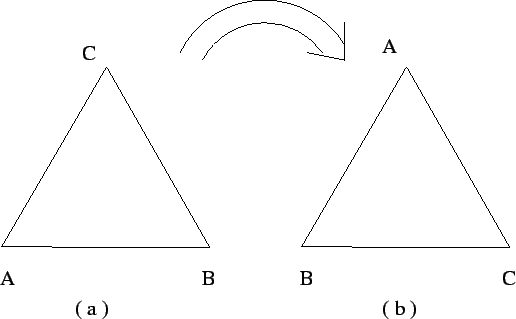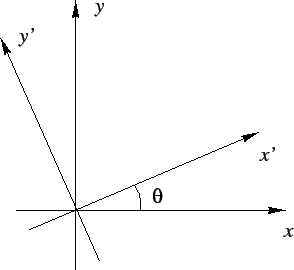


Next: Coupling Constant:
Up: Preliminaries
Previous: Mathematical ingredients:
Consider an equilateral triangle. Let a particular way of placing it,
Figure 1:
Example of a symmetry operation on a triangle
|

|
as in part (a) of fig 1, correspond to some physical situation.
If the triangle is now rotated by
 as in part (b), there
is no discernible change in the situation. If the triangle is a good representation
of the physics, the physical situation will be unchanged under this transformation.
as in part (b), there
is no discernible change in the situation. If the triangle is a good representation
of the physics, the physical situation will be unchanged under this transformation.
The equivalence to real physics is that instead of a triangle, we have vector
fields. Physics is supposed to remain unchanged under rotations or Lorenz transformation
of frames of reference. Fig. 2 shows two choices of co-ordinates,
with the x'-y' inclined at  with respect to the original
x-y system. The components of a given vector field change under such
transformations but not the physical answer calculated from them. Such operation
are called symmetry operations.
with respect to the original
x-y system. The components of a given vector field change under such
transformations but not the physical answer calculated from them. Such operation
are called symmetry operations.
Figure 2:
Choosing new co-ordinate axes rotated with respect to a given set. Such operations
are symmetries of Physics.
|

|
In 1930's the notion of such symmetry was extended by Heisenberg in a very
profound way. It is known that the strong nuclear force does not distinguish
between the proton and the neutron, or separately, among the three pions  ,
,
 and
and  .
He proposed that the strong nuclear force
is unchanged even if the physical state is an arbitrary, though linear. admixture
of the proton and the neutron. In Quantum Mechanics, the physical state of a
system is described by a complex wavefunction denoted
.
He proposed that the strong nuclear force
is unchanged even if the physical state is an arbitrary, though linear. admixture
of the proton and the neutron. In Quantum Mechanics, the physical state of a
system is described by a complex wavefunction denoted  .
Heisenberg's
proposal was that instead of using
.
Heisenberg's
proposal was that instead of using  (for proton) and
(for proton) and  (for neutrons), we could define new wavefunctions
(for neutrons), we could define new wavefunctions
 and
and
 given by
given by
and the physics would remain unchanged. Here the
 are complex numbers satisfying some constraints. The relations above can be
thought of as a complex rotation, an abstract generalisation of the case of
real vectors discussed in section 2.1. This rotation, called
an isospin rotation is a symmetry (although approximate) of the strong nuclear
force.
are complex numbers satisfying some constraints. The relations above can be
thought of as a complex rotation, an abstract generalisation of the case of
real vectors discussed in section 2.1. This rotation, called
an isospin rotation is a symmetry (although approximate) of the strong nuclear
force.



Next: Coupling Constant:
Up: Preliminaries
Previous: Mathematical ingredients:
U. A. Yajnik
2001-03-14
![]() with respect to the original
x-y system. The components of a given vector field change under such
transformations but not the physical answer calculated from them. Such operation
are called symmetry operations.
with respect to the original
x-y system. The components of a given vector field change under such
transformations but not the physical answer calculated from them. Such operation
are called symmetry operations.
